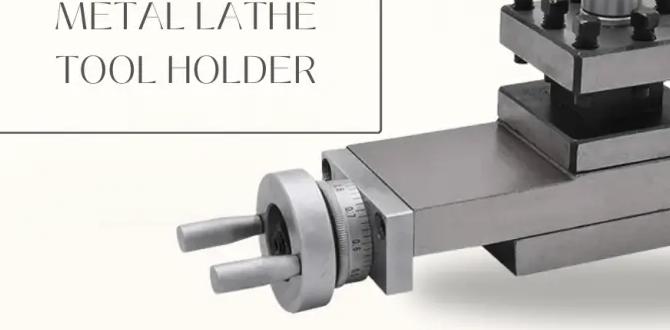A 1/8 inch carbide end mill is essential for accurately and efficiently machining titanium alloys like Grade 5. Its small diameter allows for intricate details and managing the heat generated, while carbide’s hardness resists wear, ensuring a clean cut and longer tool life compared to HSS.
Working with titanium can feel daunting, especially when you’re starting out. It’s a tough material that can quickly dull or break standard tools, leaving you frustrated and your project stalled. Many beginners wonder about the right tools for the job, particularly for precise cuts. The good news is, with the right equipment, machining titanium becomes manageable and rewarding. We’re going to focus on a crucial, often overlooked hero: the 1/8 inch carbide end mill. It might seem small, but this tiny tool packs the punch needed for tackling tricky materials like titanium. Let’s dive into why this specific tool is so important and how to use it effectively.
The Mighty 1/8 Inch Carbide End Mill: Your Titanium Milling Companion
When you’re setting up your milling machine for the first time, or even if you’ve been at it for a while, choosing the right cutting tool is paramount. This is especially true when you decide to step up to a challenging material like titanium. Titanium alloys, particularly the popular Grade 5 (Ti-6Al-4V), are known for their incredible strength, light weight, and excellent corrosion resistance. These same qualities, however, make them notoriously difficult to machine. They have low thermal conductivity, meaning heat builds up quickly at the cutting edge, and they tend to work-harden, becoming even tougher as you cut them. This is where a specialized tool like a 1/8 inch carbide end mill shines.
Why Size and Material Matter for Titanium
The choice of a 1/8 inch end mill isn’t arbitrary. Here’s why this specific combination is so critical for titanium:
- Heat Dissipation: Titanium generates significant heat during machining. A smaller diameter tool, like a 1/8 inch end mill, removes less material at any given moment. This results in less heat being generated on the cutting edge compared to a larger diameter tool. While you still need proper cooling, a smaller tool makes managing that heat much more achievable.
- Precision and Detail: A 1/8 inch end mill is ideal for creating finer details, tighter radiuses, and more intricate features in your workpiece. This is often necessary when working with titanium, where aggressive machining can quickly lead to tool failure or poor surface finish.
- Carbide’s Superiority: Tungsten carbide (often simply called carbide) is an extremely hard and rigid material. It can withstand higher temperatures and cutting forces than High-Speed Steel (HSS) tools. For titanium, which is tough and generates heat, carbide is almost always the preferred material for end mills due to its wear resistance and ability to hold an edge longer.
- Reduced Chatter: Smaller diameter tools generally experience less chatter (vibration) than larger ones, especially in tough materials. This leads to a smoother surface finish and less stress on both the tool and the machine.
Understanding the “Standard Length” and “1/4 Shank”
When you’re looking at a 1/8 inch carbide end mill for titanium, you’ll often see it specified as “standard length” with a “1/4 inch shank.” Let’s break that down:
- 1/8 Inch Cutting Diameter: This is the business end of the tool that actually does the cutting. For intricate work or managing heat on titanium, this smaller diameter is advantageous.
- 1/4 Inch Shank: The shank is the part of the end mill that fits into your milling machine’s collet or tool holder. A 1/4 inch shank is a very common size, ensuring it will fit a wide range of milling machines and collet sets.
- Standard Length: This refers to the overall length of the end mill, from the tip of the cutting edge to the end of the shank. A standard length is designed to provide a good balance between rigidity and reach, suitable for most general milling operations. You might also encounter “stub” or “extra-long” versions, but for general titanium work, standard is usually the go-to.
The Magic Combination: 1/8 Inch Carbide End Mill for Titanium Grade 5
Titanium Grade 5 (Ti-6Al-4V) is the workhorse of the titanium world, used in everything from aerospace components and medical implants to high-performance sporting goods. Its popularity comes from a great balance of strength, weight, and corrosion resistance. However, its machinability is challenging. Here’s why a 1/8 inch carbide end mill is often considered essential:
- Toughness and Abrasiveness: Grade 5 titanium is significantly stronger and harder than most steels, and it’s also abrasive. It will quickly dull less robust cutting tools.
- Low Thermal Conductivity: As mentioned, titanium doesn’t transfer heat well. Heat generated by friction during cutting gets trapped at the cutting edge, softening the tool and leading to rapid wear.
- Tendency to Work Harden: Titanium can harden significantly when deformed or cut. This means the material directly beneath the cutting edge becomes harder as you machine it, increasing cutting forces and tool wear.
A 1/8 inch carbide end mill addresses these issues by:
- Carbide’s Hot Hardness: Carbide tools maintain their hardness and cutting ability at much higher temperatures than HSS.
- Controlled Material Removal: The small diameter allows for lighter cuts, which are easier on the tool and the workpiece, and produce less heat overall.
- Fine Feature Machining: It enables the creation of precise details needed in many Grade 5 titanium parts.
Key Parameters for Machining Titanium with a 1/8 Inch End Mill
Simply having the right tool isn’t enough; you need to use it correctly. Machining titanium requires different settings than machining aluminum or mild steel. The goal is to keep the cutting edge cool and avoid excessive friction and chatter, which lead to tool breakage.
Speeds and Feeds: Finding the Sweet Spot
Speeds and feeds are critical. Getting them wrong with titanium is a fast way to disaster. For a 1/8 inch (0.125 inch) 2-flute carbide end mill, you’ll typically be on the lower end of the speed scale and higher end of the feed scale for tough materials. These are starting points, and observing the cut is crucial.
Surface Speed (SFM) for Carbide in Titanium Grade 5: Around 150-300 SFM is a common starting point. For a 1/8 inch diameter tool, this translates to an RPM (Revolutions Per Minute) of approximately:
RPM = (SFM 3.82) / Diameter (inches)
RPM = (200 SFM 3.82) / 0.125 inches ≈ 6112 RPM
Feed Rate (IPM): The feed rate determines how quickly the tool advances into the material. For tough materials like titanium, you want a chip load that’s substantial enough to prevent rubbing and allow the chip to carry heat away. For a 1/8 inch 2-flute carbide end mill, a chip load of 0.001 to 0.003 inches per tooth is a good starting range.
Feed Rate (IPM) = Chip Load (in/tooth) Number of Flutes RPM
Feed Rate = 0.002 in/tooth 2 flutes 6112 RPM ≈ 24.4 IPM
It’s essential to remember these are starting points. Factors like your specific machine’s rigidity, the length of your tool projection, the type of coolant you’re using, and the exact alloy of titanium will influence the optimal settings. Always start conservatively and listen to your machine. If you hear squealing or chatter, it’s a sign you need to adjust speeds or feeds.
Coolant and Lubrication: Your Best Friend
Machining titanium without adequate coolant or lubrication is a recipe for tool failure and poor surface finishes. The goal of the coolant is to:
- Cool the Cutting Edge: Carry heat away from the tool and workpiece.
- Lubricate the Cut: Reduce friction between the tool and the workpiece.
- Flush Chips: Remove chips from the cutting zone, preventing re-cutting and heat build-up.
For titanium, you generally want a coolant that provides good cooling and lubrication. Flood coolant systems are effective. For smaller hobbyist machines, a high-pressure mist coolant system or a specialized cutting fluid designed for titanium can be used. Never machine titanium dry.
Cutting Strategy: Climb Milling vs. Conventional Milling
When milling, you have two primary directions of cut: conventional milling and climb milling.
- Conventional Milling: The cutter rotates against the direction of feed. This tends to lift the workpiece and can cause chatter in tough materials.
- Climb Milling: The cutter rotates in the same direction as the feed. This pushes the workpiece into the table and generally results in a smoother cut, less chatter, and longer tool life, especially in materials like titanium.
For machining titanium with a 1/8 inch carbide end mill, climb milling is almost always preferred. Ensure your machine has minimal backlash in its ways for effective climb milling, especially on older machines. Modern CNC machines are generally well-suited.
Applications of the 1/8 Inch Carbide End Mill in Titanium
This versatile tool finds its way into numerous applications when working with titanium:
- Aerospace Machining: Creating complex, lightweight components for aircraft and spacecraft where precise dimensions and high strength-to-weight ratios are critical.
- Medical Implants: Machining biocompatible titanium implants, such as hip and knee replacements, where sterility and micron-level precision are non-negotiable.
- High-Performance Racing Parts: Fabricating engine components, fasteners, and chassis parts for motorsports where weight reduction and extreme durability are essential.
- Custom Knife Making: Adding intricate details or creating specific shapes on titanium knife handles or bolsters.
- Jewelry and Art: Milling fine patterns or custom designs into titanium for unique jewelry or artistic creations.
- Prototyping: Rapidly creating functional prototypes from titanium for testing and validation in various industries.
The ability to achieve intricate shapes and tight tolerances makes the 1/8 inch carbide end mill invaluable for Hobbyists and professional machinists alike working with Grade 5 titanium.
Alternatives and When to Use Them
While the 1/8 inch carbide end mill is a champion for titanium, it’s worth knowing about alternatives and their specific use cases.
High-Speed Steel (HSS) End Mills
- Pros: Generally less expensive, more forgiving of slight errors, less prone to catastrophic chipping.
- Cons: Significantly less heat resistant, dulls much faster in titanium, requires slower cutting speeds, not ideal for production runs or demanding titanium alloys.
When to use: For very light, experimental cuts on softer titanium alloys, or if you absolutely cannot get carbide and are willing to accept very slow machining speeds and frequent tool changes. Not recommended for Grade 5.
Larger Diameter Carbide End Mills
- Pros: Can remove more material faster, suitable for roughing out larger pockets or profiles.
- Cons: Generate significantly more heat, increase the risk of chatter, require more machine rigidity and power, not ideal for fine details.
When to use: For removing large volumes of material in titanium after initial roughing with smaller tools, or for roughing features that don’t require extreme precision or fine detail. Always coupled with robust cooling and careful speed/feed selection.
TiN (Titanium Nitride) or Other Coatings
Some end mills come with specialized coatings like TiN, AlTiN, or TiCN. These coatings can:
- Increase Surface Hardness: Providing better wear resistance.
- Reduce Friction: Helping chips slide off more easily and reducing heat.
- Improve Lubricity: Acting like a lubricant.
A carbide end mill with a suitable coating, such as AlTiN (Aluminum Titanium Nitride), is often even better for titanium than uncoated carbide. AlTiN performs exceptionally well at high temperatures. While a standard uncoated carbide end mill is “essential,” a coated one is often a significant upgrade.
Table: Comparing 1/8 Inch End Mills for Titanium
Here’s a quick comparison to highlight why carbide is king for titanium machining:
| Feature | 1/8″ HSS End Mill | 1/8″ Uncoated Carbide End Mill | 1/8″ AlTiN Coated Carbide End Mill |
|---|---|---|---|
| Hardness | Moderate | Very High | Extremely High |
| Heat Resistance | Low | High | Very High |
| Tool Life in Titanium | Short | Good | Excellent |
| Machining Speed | Slow | Moderate to Fast | Fast |
| Cost | Low | Medium | Higher |
| Best For | Light, non-critical cuts | General Titanium Machining | Demanding Titanium Machining, extended tool life |
Essential Accessories for Titanium Machining
Beyond the end mill itself, having the right accessories will ensure success and safety:
- Rigid Tool Holder/Collet: A high-quality ER collet chuck or a similar rigid tool holding system is vital. Loose tool holders lead to runout, chatter, and premature tool failure. Ensure your collets are clean and provide a tight grip.
- Coolant System: As discussed, a flood, mist, or through-spindle coolant system is a must.
- Workholding: Securely clamp your titanium workpiece. Use appropriate methods that won’t distort the material and can withstand the cutting forces. Soft jaws or specialized fixtures are often used.
- Safety Glasses: Always wear safety glasses. Titanium chips can be sharp and unpredictable.
- Chip Guards: Keep your machine’s splash guards in place to contain chips and coolant.
- Dust Collection (if applicable): If doing extensive dry machining (not recommended for titanium but relevant for some materials), ensure robust dust collection for fine metal particulate.
For the most robust setup, consider looking into specialized tooling suppliers. For example, companies like Sandvik Coromant offer extensive resources and tooling specifically designed for challenging materials like titanium, providing valuable insights for advanced users.
Safety First: Machining Titanium Responsibly
Machining titanium presents unique safety challenges. Always follow these guidelines:
- Eye Protection: Always wear ANSI Z87.1 compliant safety glasses or a face shield.
- Hearing Protection: Machining can be loud; use earplugs or earmuffs.
- Be Aware of Flammability: While solid titanium is not highly flammable, fine titanium dust or chips can ignite under certain conditions when mixed with air or other oxidizers. Keep your workspace clean of excessive dust.
- Chip Management: Titanium chips can be sharp and may remain hot for some time after cutting. Avoid touching them. Use a brush or magnet to clear chips, never your hands.
- Machine Operation: Never leave a running machine unattended. Understand your machine’s emergency stop procedures.
- Tool Condition: Regularly inspect your end mills for wear or damage. A worn tool is more likely to break unexpectedly.
Frequently Asked Questions (FAQ)
Q1: Can I use HSS end mills for titanium?
While you can technically make a cut with an HSS end mill, it’s highly discouraged for any serious work with titanium, especially Grade 5. HSS dulls extremely quickly due to the heat and toughness of titanium, leading to poor surface finishes, increased cutting forces, and rapid tool failure. Carbide is far superior.
Q2: What kind of coolant is best for titanium with a 1/8 inch end mill?
You need a coolant that provides both excellent cooling and good lubrication. Flood coolant systems are ideal. If using a mist system, ensure it’s specifically designed for metal machining and delivers a substantial amount of fluid. Specialized cutting fluids formulated for difficult-to-machine alloys like titanium are also a good option. Never machine titanium dry.
Q3: How deep can I cut into titanium with a 1/8 inch end mill?
The depth of cut (DOC






